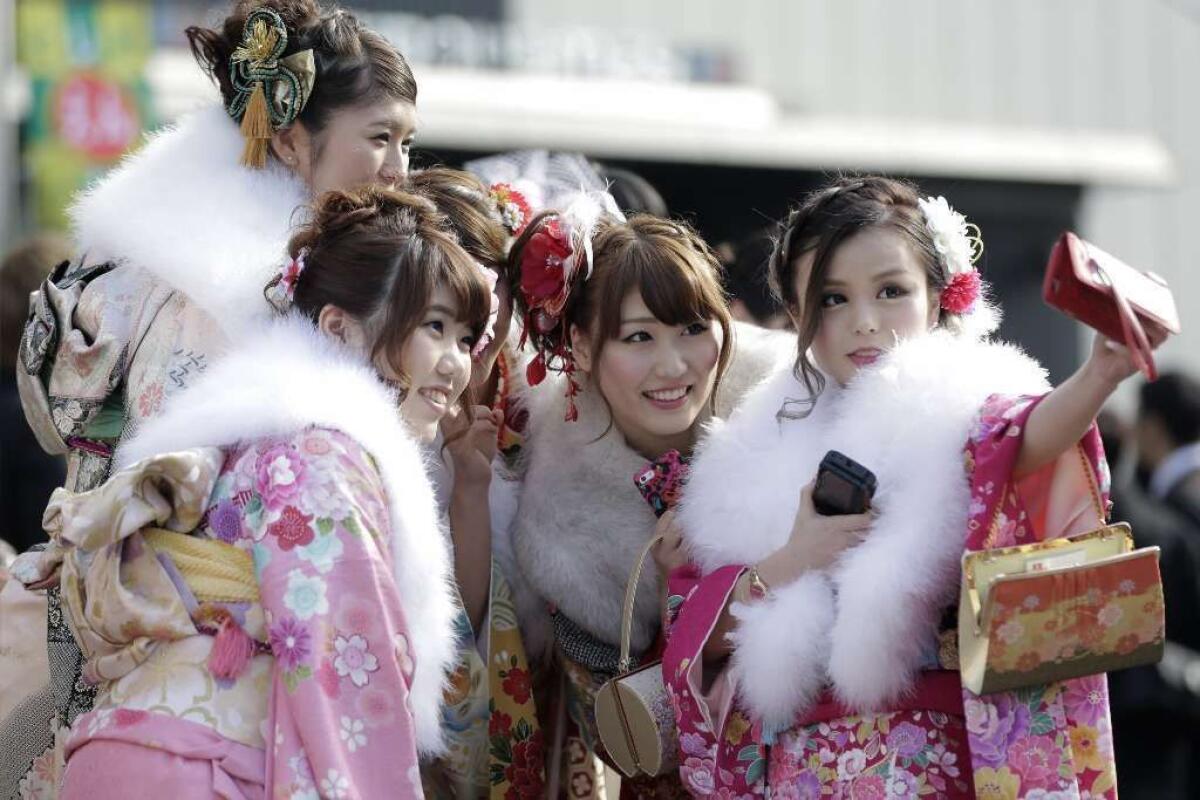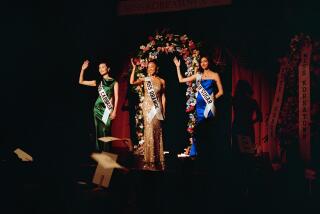Commentary: Yes, Kim Kardashian’s ‘Kimono’ is cultural appropriation. And she’s not alone

- Share via
A Japanese word that means “a thing to wear,” “kimono” commonly refers to traditional Japanese garments that have been around for hundreds of years. Furisode, iromuji, mofuku and yukata are just a few of the different types of kimonos that are still worn for different occasions.
It’s not at all a word associated with undergarments, but Kim Kardashian West is trying to change that. On Tuesday — less than a month after the last day of Asian Pacific American Heritage Month — the reality star and beauty mogul launched Kimono Solutionwear, her shapewear line meant to be inclusive of a range of body shapes, sizes and skin tones.
And she’s filed paperwork to trademark “Kimono” (as well as “Kimono Body,” “Kimono Intimates” and “Kimono World”). Because what’s a new entrepreneurial venture without protecting your brand?
But Kardashian West’s appropriation of the word “kimono” for a line of products that have nothing to do with kimonos is problematic because it completely removes the word from any cultural or historical contexts. Her marketing decision ignores and erases both Japanese tradition and very specific Japanese American experiences.
Kim Kardashian just trademarked ‘Kimono.’ Let the backlash begin »
Many were quick to point out that this is just the latest in Kardashian West’s history of being culturally insensitive. She has previously been called out for wearing Fulani braids (more than once) and a maang tikka (an Indian headpiece). She also has been accused of blackface in ads for her beauty line.
Members of Kardashian’s high-profile family — including Kendall and Kylie Jenner — have been accused of profiting off of black culture, too, so it appears Kim is just switching it up a bit by looking to Asian culture for inspiration.
Kardashian West’s attempt to have “kimono” associated with her and her brand is just a new low in ways people of Japanese descent have their culture and identity taken from them.
In Japan, although some people still wear everyday kimonos, the traditional attire is more often something worn for special occasions. Different types of kimonos are appropriate for different events, including various ceremonies, celebrations, festivals and other milestones in life.
Many Japanese Americans also associate kimono with special occasions. Often, kimonos are more than just ceremonial attire; they’re pieces of a family’s history and a connection to their heritage. Some kimonos are family heirlooms, passed down from mother to daughter, and are a part of their identity.
It’s important to remember that many Japanese Americans were robbed of this connection to their heritage and culture when 120,000 people of Japanese descent — most of them U.S. citizens — were taken from their homes to be locked up in internment camps during World War II.
These families were seen as “the enemy” just for being of Japanese descent: For owning kimonos and other cultural items, for speaking Japanese within their community and for being successful despite laws that prohibited Japanese immigration and barred Japanese immigrants from American citizenship and owning land.
These Japanese Americans were forced to choose between everyday essentials and items that were significant to their family when packing up the possessions they could carry to these camps for indefinite incarceration. Some took their kimonos, but others who left them behind lost them to looting and vandalism while they were locked away.
In addition to actual property loss, these Japanese Americans were subjected to racist attitudes and programs meant to strip them of their cultural identity to encourage “Americanization” (though some traditions endured). Internment was a collective trauma that continues to have repercussions, with many vocal critics who argue it should never be repeated.

So, yes, it is problematic that someone has decided to overlook the complicated American history around people of Japanese descent and Japanese culture in order to create a brand around a word that is already loaded with meaning.
Of course, Kardashian West is not the first person to misuse the word “kimono” or misfire when it comes to Asian culture.
The fashion world has long struggled with the line between cultural appropriation and appreciation. For Asians and Asian Americans, this has meant everything from the use of “yellowface” to items with cultural significance being turned into the must-have accessories for music festival season.
Plenty of brands use the word “kimono” to sell flowy, robelike apparel that doesn’t particularly resemble any traditional kimono. The word often is used as shorthand to indicate an item is supposedly inspired by Japanese clothing but it is more like a caricature than any authentic representation.
(Hollywood is similarly guilty of its own offenses regarding Asian and Asian American representation.)
But Kardashian West’s “Kimono” line goes one step further by completely dissociating the word from anything approximating its Japanese roots. And that’s a problem.
Twitter: @tracycbrown
More to Read
The biggest entertainment stories
Get our big stories about Hollywood, film, television, music, arts, culture and more right in your inbox as soon as they publish.
You may occasionally receive promotional content from the Los Angeles Times.











